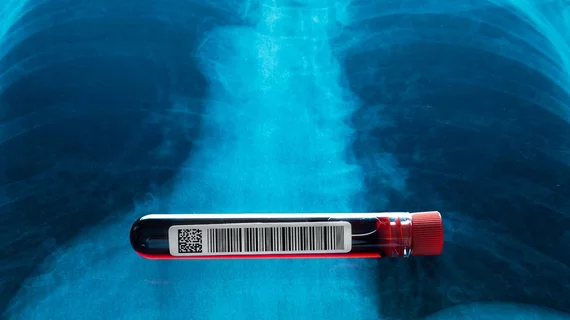A novel blood test may help more accurately predict which patients would benefit from CT lung cancer screening, according to research published Friday in the Journal of Clinical Oncology.
Combined with a risk model that also factors in an individual’s smoking history, this approach could improve upon screening recommendations from the U.S. Preventive Services Task Force, experts noted. MD Anderson researchers estimate their model would pinpoint 9% additional lung cancer cases for screening while also reducing unnecessary imaging referrals by nearly 14% compared to USPSTF guidance.
“Our goal, for many years, has been to develop a simple blood test that can be used first to determine need for screening and make screening for lung cancer that much more effective,” author Sam Hanash, MD, PhD, a professor of clinical cancer prevention at the University of Texas MD Anderson Cancer Center in Houston, said Jan. 7. “Our study shows for the first time that a blood test could be useful to determine who may benefit from lung cancer screening.”
For their analysis, Hanash et al. included participants from the Prostate, Lung, Colorectal and Ovarian (PLCO) Cancer Screening Trial who had at least a 10 pack-year smoking history. Their blood test uses biomarkers previously proven to predict lung cancer risk. Research teams across multiple centers evaluated performance of the blood test in combination with a PLCO model able to predict six-year risk for lung cancer among current and former smokers.
They measured this approach up against 2021 USPSTF guidance, recommending annual CT screening for individuals ages 50 to 80 and who have at least a 20 pack-year history, among other criteria. All told, the analysis incorporated 10,000 biospecimens from the National Cancer Institute PLCO study. That included blood samples from 552 individuals who developed lung cancer and 2,193 more who did not.
Among participants with at least a 10 pack-year history—or a pack of cigarettes smoked per day for a decade—the blood model bolstered sensitivity to 88.4% versus 78.5% for USPSTF criteria. Specificity also improved, jumping from 49.3% to 56.2%. Hanash and co-authors estimate that implementing their combined risk model would pinpoint 105 of the 119 individuals (88%) who received a lung cancer diagnosis within the first year.
“A blood test would identify people who could benefit from lung cancer screening but are not eligible today,” Hanash said in a statement. “Tens of millions of people worldwide could benefit from lung cancer screening. If you can improve screening eligibility by even 5%, that is incredibly impactful.”
Investigators believe their blood test could be implemented in labs in the “near future.” But it would first require evaluation through a prospective clinical trial before gaining U.S. Food and Drug Administration approval.
Read more about their work in the American Society of Clinical Oncology’s official journal here.

